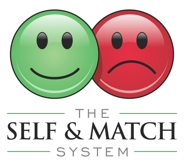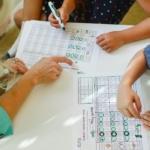5 Steps to Creating and Maintaining Classroom Expectations
The First Step of Teaching Self-Monitoring and Implementation of The Self & Match System
One simple way to support student’s in-class behavioral success is to prioritize setting clear expectations and then systematically teaching our students the tools needed to self-monitor their behavior(s) to match these expectations using Self & Match. All students thrive on having expectations and the value of setting clear classroom expectations has been researched for over 70 years. So, let’s take a look at some key tips to setting up effective classroom expectations as well as tools to teach self-monitoring as we go back to the basics and prepare our students to be successful, lifelong learners.
5 Tips to Consider as You Set Classroom Expectations With Your Students
1) Create 3-5 clear/explicit class expectations that are stated positively.
Set expectations of what you would like your student to do (i.e. “Be Responsible by coming to class on time”) rather than what you don’t want your student to do (i.e. “Don’t Come to Class Late”).
2) Make the expectations easy to remember, simple to understand, age-appropriate, and enforceable.
Ensure that all students can identify the class expectations and, if possible, explain them in their own words. Consider incorporating visuals and teach examples and non-examples that align with each expectation. Remember to use language that is familiar to your students, make it fun, tied to your classroom themes, school-wide PBIS culture, and (if applicable) your Self & Match System Questions! For example, if you have a space themed classroom, using terms like “Out of this world!” might be language to reinforce the expectations and connect for your students.
3) If possible, co-construct the expectations with your students and allow them to have a voice in the process of creating and setting expectations.
If a class expectation is to “Be Kind”, ask your students what “Being Kind” means to them and include the student definitions on the clearly posted expectations within the classroom. Allow students to develop clear examples and non-examples of the class expectations and remember that the examples can be added to or modified throughout the year. Including example(s) and non-examples increases the rate at which students follow through with classroom expectations.
4) Promote fluency by explicitly teaching and practicing the expectations.
Go further than simply posting the expectations in a visible location by referencing them frequently, make it a part of your daily schedule, and (if applicable) review at each Self & Match check-in opportunity. Infuse the language of the expectations throughout your school day by catching students engaging in the class expectation and reinforcing/labelling it (i.e. – “Kai, I love the way you are Following Directions by starting your classwork”).

5) Empower students to take ownership and responsibility for their own behavior. Recognizing expectations is the first step of teaching self-monitoring within an educational setting.
In its simplest terms, self-management involves the personal/self-application of behavior-change procedures that supports goal achievement. How can we expect students to accurately reflect on their behavior, if they do not have a clear understanding of the expectations? This is why it is critical that the first step you take is establishing classroom expectations with your students.
Our ultimate goal is to provide you with practical tools to help students monitor and reflect on their own behavior so that they can become more independent and self-determined, resulting in an improved quality of life!
The First Step of Teaching Self-Monitoring and Implementation of The Self & Match System
One simple way to support student’s in-class behavioral success is to prioritize setting clear expectations and then systematically teaching our students the tools needed to self-monitor their behavior(s) to match these expectations using Self & Match. All students thrive on having expectations and the value of setting clear classroom expectations has been researched for over 70 years. So, let’s take a look at some key tips to setting up effective classroom expectations as well as tools to teach self-monitoring as we go back to the basics and prepare our students to be successful, lifelong learners.
5 Tips to Consider as You Set Classroom Expectations With Your Students
1) Create 3-5 clear/explicit class expectations that are stated positively.
Set expectations of what you would like your student to do (i.e. “Be Responsible by coming to class on time”) rather than what you don’t want your student to do (i.e. “Don’t Come to Class Late”).
2) Make the expectations easy to remember, simple to understand, age-appropriate, and enforceable.
Ensure that all students can identify the class expectations and, if possible, explain them in their own words. Consider incorporating visuals and teach examples and non-examples that align with each expectation. Remember to use language that is familiar to your students, make it fun, tied to your classroom themes, school-wide PBIS culture, and (if applicable) your Self & Match System Questions! For example, if you have a space themed classroom, using terms like “Out of this world!” might be language to reinforce the expectations and connect for your students.
3) If possible, co-construct the expectations with your students and allow them to have a voice in the process of creating and setting expectations.
If a class expectation is to “Be Kind”, ask your students what “Being Kind” means to them and include the student definitions on the clearly posted expectations within the classroom. Allow students to develop clear examples and non-examples of the class expectations and remember that the examples can be added to or modified throughout the year. Including example(s) and non-examples increases the rate at which students follow through with classroom expectations.
Go further than simply posting the expectations in a visible location by referencing them frequently, make it a part of your daily schedule, and (if applicable) review at each Self & Match check-in opportunity. Infuse the language of the expectations throughout your school day by catching students engaging in the class expectation and reinforcing/labelling it (i.e. – “Kai, I love the way you are Following Directions by starting your classwork”).

5) Empower students to take ownership and responsibility for their own behavior. Recognizing expectations is the first step of teaching self-monitoring within an educational setting.
In its simplest terms, self-management involves the personal/self-application of behavior-change procedures that supports goal achievement. How can we expect students to accurately reflect on their behavior, if they do not have a clear understanding of the expectations? This is why it is critical that the first step you take is establishing classroom expectations with your students.
Our ultimate goal is to provide you with practical tools to help students monitor and reflect on their own behavior so that they can become more independent and self-determined, resulting in an improved quality of life!



